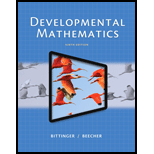
Concept explainers
When subtracting rational expressions, parentheses are important to make sure that you subtract the entire numerator. In Exercises RC1–RC3, complete each numerator by (a) filling in the parentheses, (b) removing the parentheses, and (c) collecting like terms.
RC 1.
Want to see the full answer?
Check out a sample textbook solution
Chapter 12 Solutions
Developmental Mathematics (9th Edition)
- 21:46 MM : 0 % sparxmaths.uk/studer Sparx Maths + 13 24,963 XP Andrey Roura 1A ✓ 1B X 1C 1D Summary Bookwork code: 1B 歐 Calculator not allowed Write the ratio 3 : 1½ in its simplest form. 32 Menuarrow_forwardPLEASE SOLVE STEP BY STEP WITHOUT ARTIFICIAL INTELLIGENCE OR CHATGPT SOLVE BY HAND STEP BY STEParrow_forward2.- Solve the following Homogeneous Differential Equation (xy + 3y²+x²)dx − (x² + 2xy)dy = 0 -arrow_forward
- Write a Regression summary explaining significance of mode, explaining regression coefficients, significance of the independent variables, R and R square. Premiums earned Net income Dividends Underwriting Gain/ Loss 30.2 1.6 0.6 0.1 47.2 0.6 0.7 -3.6 92.8 8.4 1.8 -1.5 95.4 7.6 2 -4 100.4 6.3 2.2 -8.1 104.9 6.3 2.4 -10.8 113.2 2.2 2.3 -18.2 130.3 3.0 2.4 -21.4 161.9 13.5 2.3 -12.8 182.5 14.9 2.9 -5.9 193.3 11.7 2.9 -7.6arrow_forward1. Show that the vector field F(x, y, z) = (2x sin ye³)ix² cos yj + (3xe³ +5)k satisfies the necessary conditions for a conservative vector field, and find a potential function for F.arrow_forward1. Newton's Law of Gravitation (an example of an inverse square law) states that the magnitude of the gravitational force between two objects with masses m and M is |F| mMG |r|2 where r is the distance between the objects, and G is the gravitational constant. Assume that the object with mass M is located at the origin in R³. Then, the gravitational force field acting on the object at the point r = (x, y, z) is given by F(x, y, z) = mMG r3 r. mMG mMG Show that the scalar vector field f(x, y, z) = = is a potential function for r √√x² + y² . Fi.e. show that F = Vf. Remark: f is the negative of the physical potential energy, because F = -V(-ƒ).arrow_forward
 Elementary AlgebraAlgebraISBN:9780998625713Author:Lynn Marecek, MaryAnne Anthony-SmithPublisher:OpenStax - Rice University
Elementary AlgebraAlgebraISBN:9780998625713Author:Lynn Marecek, MaryAnne Anthony-SmithPublisher:OpenStax - Rice University College AlgebraAlgebraISBN:9781305115545Author:James Stewart, Lothar Redlin, Saleem WatsonPublisher:Cengage Learning
College AlgebraAlgebraISBN:9781305115545Author:James Stewart, Lothar Redlin, Saleem WatsonPublisher:Cengage Learning Algebra: Structure And Method, Book 1AlgebraISBN:9780395977224Author:Richard G. Brown, Mary P. Dolciani, Robert H. Sorgenfrey, William L. ColePublisher:McDougal Littell
Algebra: Structure And Method, Book 1AlgebraISBN:9780395977224Author:Richard G. Brown, Mary P. Dolciani, Robert H. Sorgenfrey, William L. ColePublisher:McDougal Littell


